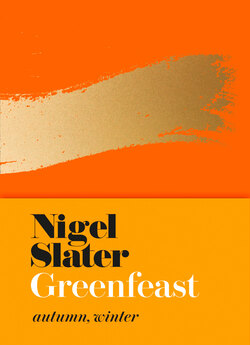Читать книгу Greenfeast - Nigel Slater - Страница 8
ОглавлениеWINTER STOCK
A good vegetable stock is worth its weight in gold on a winter’s day. As the nights draw in, we probably need a stock altogether deeper, richer and more ballsy than the delicate, vegetal liquids we might use in summer. Something that behaves more like a brown meat stock. Such a broth is immensely useful in my kitchen as a base for the heartier non-meat recipes that form the backbone of my daily eating, but also as something restoring to drink as you might a cup of miso. The colour must be dark and glossy, the flavour deeply, mysteriously herbal with a hint of mushroom and there should be a roasted back note, the sort you find in a long-simmered meat stock.
As you proceed, the kitchen will fill with the smell of onions, celery and carrots, which you roast with miso paste, then remove from the oven and simmer for a good hour with thyme, bay and shiitake. You could slip in a sheet of kombu for an extra layer of depth if you like.
The broth will need straining and separating from its spent aromatics, its deep, almost mahogany liquor dripping slowly into a glass bowl. The liquor can be used immediately, or kept in the fridge, covered, for up to a week.
Such a stock is a bowl of pure treasure. You can drink it like broth, dipping thick hunks of bread or focaccia into it; you can use it as base for a soup, adding steamed cauliflower or shredded cabbage, parsley and croutons, or add noodles, skeins of udon or little pasta stars to twinkle in the dark, mushroomy depths. Whenever the word ‘stock’ appears in a recipe, use it neat or let it down with a little water to taste. And it will freeze too, though I suggest in small containers, so it defrosts quickly.
And when all is said and done, is there anything quite so restoring as coming home to a bowl of deeply layered, smoky stock, to bubble on the stove, to which you add pieces of hot toast, letting them slowly swell with the bosky, fungal, roasted flavours from the bowl.
WINTER PORRIDGE
A winter’s day should start well. A steaming bowl of something to see us on our way. I invariably choose porridge. An oat-based slop to satisfy and strengthen, to bolster and soothe, to see me through till I get where I’m going. A sort of internal duffel coat. I doubt it will just be porridge of course, but porridge with bells and whistles: a trickle of treacle, a pool of crème fraîche, ribbons of maple syrup or a puddle of yoghurt. There may be golden sultanas and dried mulberries, pistachios or toasted almonds and perhaps some baked figs or slices of banana.
Porridge doesn’t necessary mean oats. You could use rye grain or barley and milk or water as you wish. There might be salt or sugar, cinnamon or ground cardamom or toasted pumpkin seeds. If I remember, there will be stewed fruit too: apples perhaps, or dried apricots cooked with sugar or honey. Porridge is never just porridge in my house. It is a winter staple, one of the building blocks of the season and something I could never think of being without.
A BROWN VEGETABLE STOCK
Deep flavours. A herbal, umami-rich stock for winter cooking.
Makes about 2 litres
onions, medium 2
carrots 250g
celery 2 sticks
garlic a small, whole head
light miso paste 3 tablespoons
water 80ml, plus 3 litres
dried shiitake mushrooms 50g
rosemary 5 sprigs
thyme 10 sprigs
bay leaves 3
black peppercorns 12
dried kombu 10g
Set the oven at 180°C/Gas 4. Peel and roughly chop the onions, then place in a roasting tin together with the skins. Similarly chop the carrots and celery sticks, then mix with the onions and the head of garlic, separated into cloves.
Mix together the miso paste and 80ml of water, then stir into the vegetables, coating them lightly. Bake for about an hour, tossing the vegetables once or twice during cooking, until everything is brown, fragrant and toasty.
Transfer the roasted vegetables and aromatics to a deep saucepan, add the shiitake, rosemary, thyme, bay, peppercorns and the sheets of kombu, then pour a little of the reserved water into the roasting tin, scrape at the sticky, caramelised bits stuck to the tin, then pour into the saucepan. Add the remaining water. Bring to the boil, then lower the heat and leave to simmer, partially covered with a lid, for fifty minutes to an hour.
When you have a deep brown, richly coloured broth, tip through a sieve into a heatproof bowl or large jug and leave to cool. Refrigerate and use as necessary.
• Keeps for up to one week in the fridge.
OATS, DRIED MULBERRIES, DATE SYRUP
The solace of porridge. The sweetness of dried fruits.
Serves 2
porridge oats 100g
dried mulberries 50g
golden sultanas 75g
cream or crème fraîche 4 tablespoons
date syrup 2 tablespoons
Put the oats and 400ml of water into a small saucepan and bring them to the boil. Add a good pinch of salt and stir the oats continuously for four or five minutes with a wooden spoon until the porridge is thick and creamy.
Divide between two bowls, then add the dried mulberries and golden sultanas. Add spoonfuls of crème fraîche, then trickle over the date syrup.
• I often use dried apricots in place of the mulberries, but cranberries and dried cherries are good alternatives.
• The sweetness of the date syrup can be balanced by a spoon or two of stewed tart apples.
